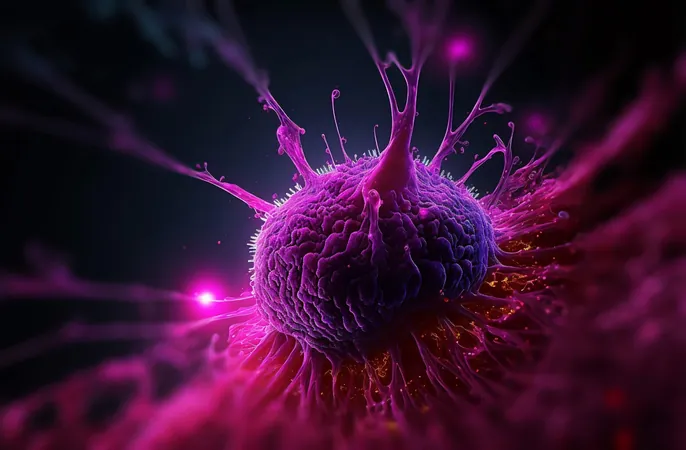
Groundbreaking Breakthrough in Cell Migration Research: A New Hope in the Fight Against Cancer!
2025-01-22
Author: Ting
Groundbreaking Breakthrough in Cell Migration Research: A New Hope in the Fight Against Cancer!
In an exciting new discovery, scientists have unveiled groundbreaking insights into the mechanisms of cell migration, which could propel the fight against cancer to unprecedented heights. The research focuses on filopodia, tiny, finger-like projections that extend from cells, crucial for their movement through the surrounding environment.
Filopodia are not just essential for healthy biological functions, such as the immune response – where they guide immune cells to infection sites – but they also play a sinister role in cancer. Metastatic cancer cells cleverly exploit these extensions to invade new tissues, facilitating the dangerous spread of cancer within the body.
Unlocking the Secrets of Filopodia
For decades, researchers have sought to understand the structural intricacies of filopodia’s protein bundles. A group of scientists at Rockefeller University’s Laboratory of Structural Biophysics and Mechanobiology recently made significant strides in cracking the code.
In their study, published in Nature Structural & Molecular Biology, they have elucidated how the atomic-level assembly of protein scaffolding in filopodia occurs. This groundbreaking discovery could illuminate new paths for cancer therapies aimed at combating metastasis.
“Understanding the structure of filopodia and the changes they undergo may help to refine existing therapies or inspire entirely new ones,” stated Rui Gong, the study’s lead author.
The Filopodia Structure: Complexity and Cancer Connection
Filopodia are constructed from bundles of actin filaments, with a fundamental protein known as fascin strengthening and stabilizing these structures. Actin forms the cytoskeleton’s backbone but is too weak to function effectively on its own. "It’s like a floppy noodle," explained Gregory M. Alushin, head of the Rockefeller Lab, emphasizing that actin filament bundles are necessary to perform any substantial cellular function.
Fascin's critical role lies in forming strong yet flexible structures that enable filopodia to function effectively. Achieving the right balance between strength and adaptability is paramount. “They hit a sweet spot between strength and flexibility,” Alushin said.
Despite the known importance of fascin, understanding the precise mechanics of its assembly remained a challenging mystery. An innovative approach using advanced imaging techniques like cryo-electron microscopy has now delivered clearer insights into filopodia’s internal architecture.
A Revolutionary Breakthrough in Imaging
The Rockefeller team has achieved a significant breakthrough by utilizing advanced computational image analysis, allowing them to visualize the intricate structures of fascin proteins bridging actin filaments. This has led to unprecedented atomic-level clarity.
“We saw real bundles composed of thousands of fascin molecules and hundreds of actin filaments, and we were able to map their spatial positioning,” Gong shared. Notably, the researchers discovered fascin’s remarkable flexibility, allowing it to adapt to the structures of actin filaments, which are often twisted and uneven.
The versatile behavior of fascin proteins is a crucial adaptation to properly form the robust hexagonal bundles essential for cellular movement.
Implications for Cancer Treatment
Fascin's role extends beyond basic cell biology – it is a key player in cancer metastasis. An excess of fascin can lead cancer cells to build filopodia excessively, enhancing their ability to invade other tissues.
Researchers are currently testing fascin inhibitors, drugs that aim to prevent cancer cells from utilizing filopodia for migration. The recent study indicates a new mechanism for these inhibitors; rather than merely blocking fascin’s binding sites, they impede the necessary shape changes for binding.
This novel understanding of fascin paves the way for designing more effective cancer therapies that can thwart metastatic processes. Moreover, these findings open the door to further research into other cellular processes reliant on actin bundling, potentially transforming our comprehension of cell movement across various biological systems, from the immune response to neurological functions.
In conclusion, the Rockefeller team’s findings present a beacon of hope in the ongoing battle against cancer by offering paths to innovate and customize cancer therapies focused on the mechanics of cell migration. Researchers may finally be on their way to unlocking powerful new methods to halt cancer's relentless spread, bringing new hope for patients and their families.
Stay tuned for more thrilling discoveries in medical science and breakthroughs that can change the course of healthcare!



 Brasil (PT)
Brasil (PT)
 Canada (EN)
Canada (EN)
 Chile (ES)
Chile (ES)
 Česko (CS)
Česko (CS)
 대한민국 (KO)
대한민국 (KO)
 España (ES)
España (ES)
 France (FR)
France (FR)
 Hong Kong (EN)
Hong Kong (EN)
 Italia (IT)
Italia (IT)
 日本 (JA)
日本 (JA)
 Magyarország (HU)
Magyarország (HU)
 Norge (NO)
Norge (NO)
 Polska (PL)
Polska (PL)
 Schweiz (DE)
Schweiz (DE)
 Singapore (EN)
Singapore (EN)
 Sverige (SV)
Sverige (SV)
 Suomi (FI)
Suomi (FI)
 Türkiye (TR)
Türkiye (TR)
 الإمارات العربية المتحدة (AR)
الإمارات العربية المتحدة (AR)